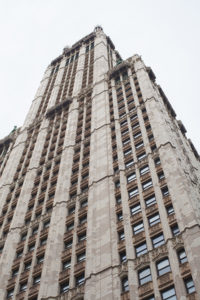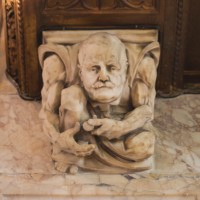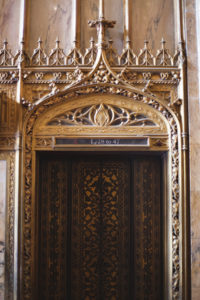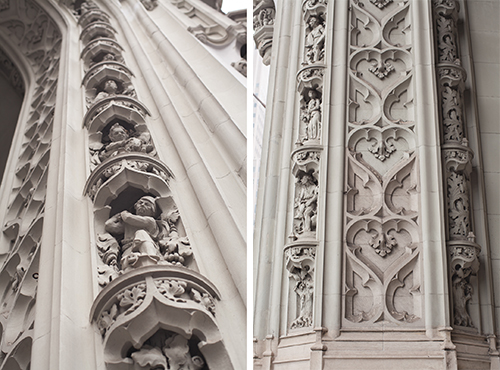
At 60 stories high, the Woolworth Building was the tallest in the world when it was built in 1913. (Photos by David Yuan)
Although I've been an architect for 27 years, and lived in New York City for 33, until recently I had largely overlooked one of the city's most famous buildings.
Two weeks ago RAND's Historic Preservation team went on a private tour of the iconic Woolworth Building. I've walked by the building plenty of times over the years but had stepped into the lobby briefly only once, and that was about 25 years ago. So I was particularly interested in going on this tour to get a closer look at this glorious structure.
I learned a number of historical tidbits about the building. Located near City Hall at 233 Broadway in downtown Manhattan, the 60-story Woolworth Building was the tallest building in the world when it was completed in 1913. It held that title until 1930, when it was surpassed in height by 40 Wall Street—which itself lost that distinction to the Chrysler Building a few weeks later.
Designed in a neo-Gothic style by famed architect Cass Gilbert, the 792-foot edifice features elaborate ornamentation, most notably the cream-colored terra cotta carvings with blue and yellow highlights. The Woolworth Building was named a National Historic Landmark in 1966 and a New York City Landmark in 1983. The building recently made headlines when it was announced that the top 30 floors would be converted into luxury condominium apartments, including a five-story penthouse at the top.
Our tour guide pointed out that many of the original terra cotta units that lost their glaze were replaced with a grayish cast stone during a renovation in the 1970s. At the spire level, many of the lacy finials were deemed unstable and were removed and stored for safe keeping.
As impressive as its limestone exterior is, the interior of the "Cathedral of Commerce," as it was dubbed early on, is equally spectacular. The building was open to the public until September 11, 2001, but now only people who work in the building and authorized guests—including lucky tour groups like us—are allowed in. Our guide led us through the cross-shaped lobby, which was built with access to the subway system through the cellar. The vaulted lobby space features honey-colored marble walls, cast-bronze elevator doors, and ceilings of mosaic tile, gold tesserae, and stained glass.

A caricature of company founder Frank Woolworth counting coins from his chain of "five and dime" stores.
One of the highlights of the tour for me was seeing the grotesques of key figures in the building's construction perched along the spring points of stone arches. The cast of caricatures includes the architect Gilbert cradling a miniature of the building in his lap; Gunvald Aus, the building's engineer, grasping onto a steel beam; and Frank Woolworth himself, counting the nickels and dimes from the chain of "five and dime" stores he founded.
From now on when I view the city's downtown skyline, I know the Woolworth Building will stand out to me. The tour gave me a much a greater appreciation of the building and its magnificent details that make it such an important part of New York's architectural splendor.


